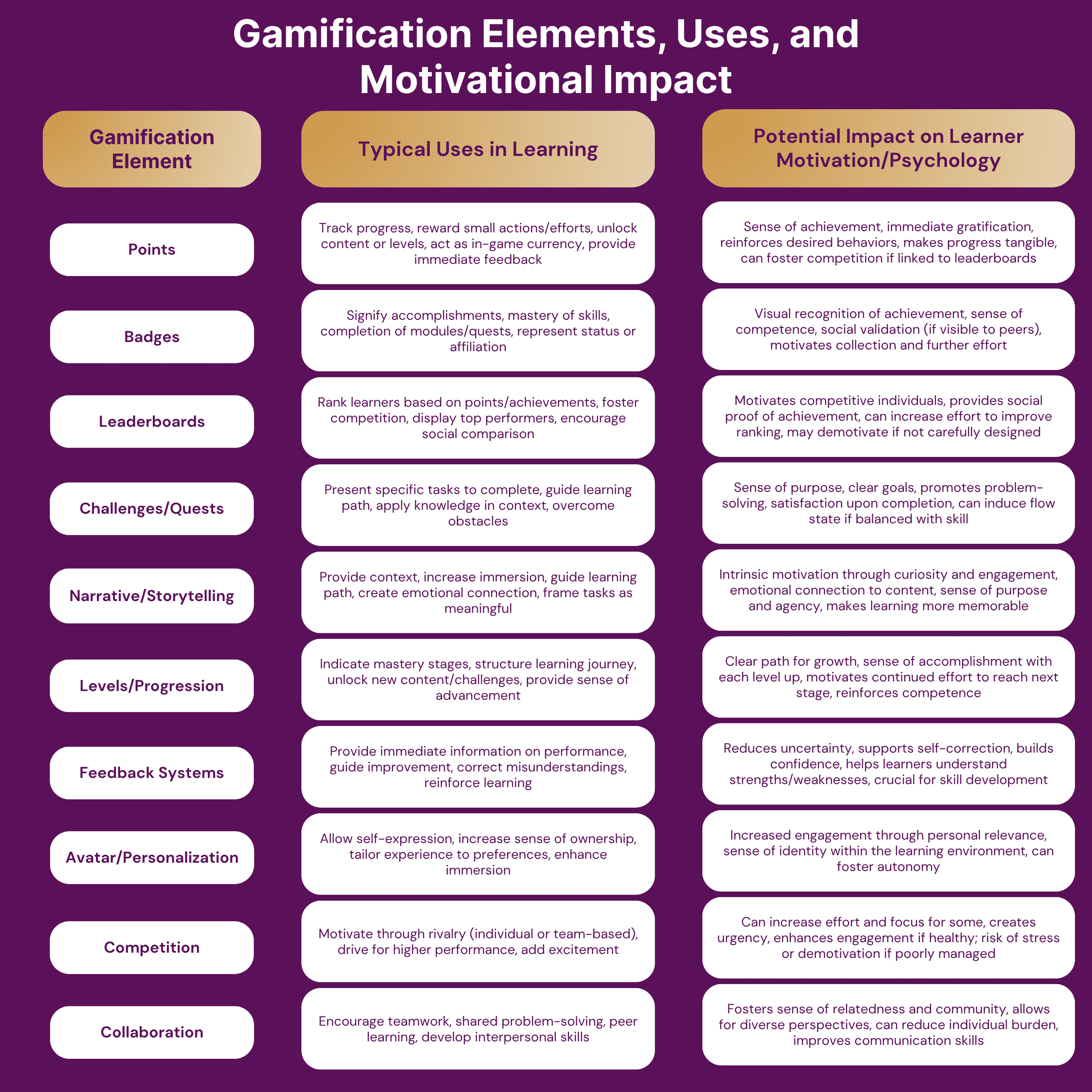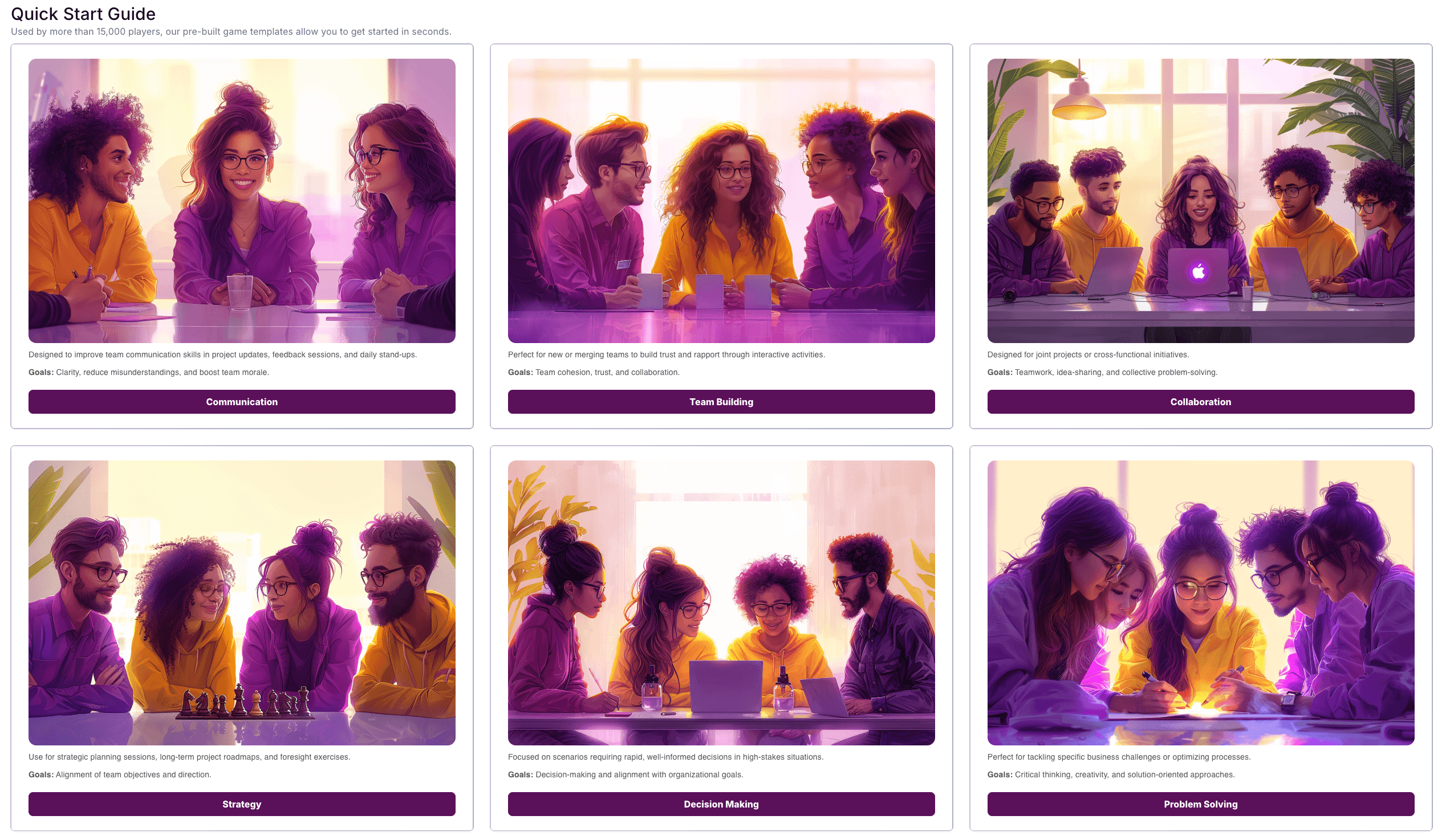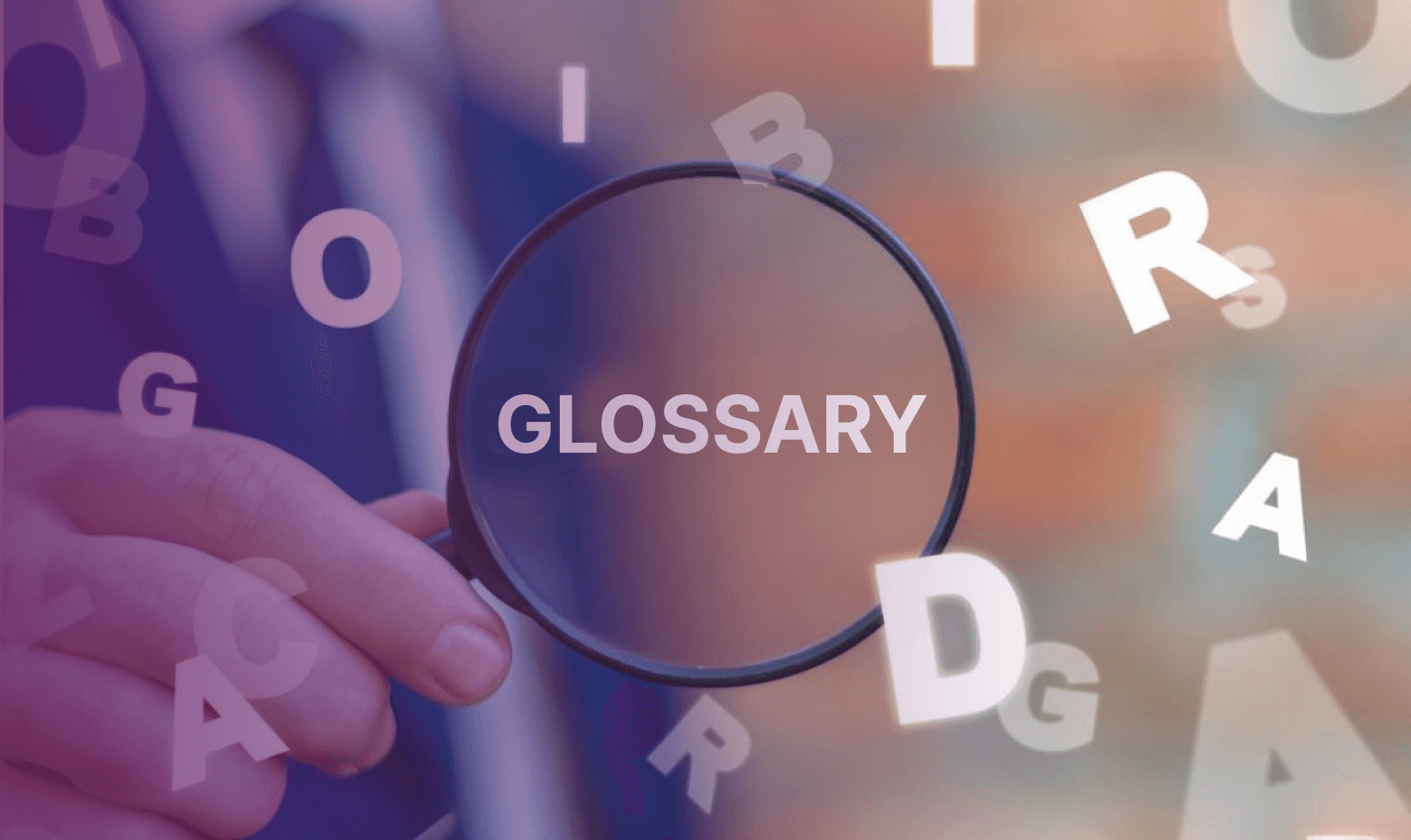Introduction: The Power of Play in Learning
Integrating game-like elements into education transforms learner engagement and skill development. This approach, gamification, uses the enjoyment of play for more compelling learning journeys.
Defining Gamified Learning Experiences
Gamification is an educational strategy creating immersive, engaging, student-centered learning environments. It can turn knowledge acquisition into a collective or competitive adventure.
It involves integrating game elements (points, badges, leaderboards) into non-game learning activities to boost engagement and motivation. This differs from game-based learning, where activities are intrinsically games.
Strategic Thinking in course design is key. This includes offering multiple success paths and environments for "safe failures" in low-stakes practice. The pedagogical foundation often outweighs technology.
Gamification's core value isn't just adding points; it's a pedagogical shift to rethink learning. It emphasizes learner-driven, flexible, resilient learning, not just layering game mechanics onto traditional methods. Educators should prioritize clear goals and learner needs before selecting gamification elements.
Why Gamification Matters for Engagement and Outcomes
Gamification makes learning highly interactive, fostering participation, curiosity, and enthusiasm. Such engagement is a primary driver of successful learning.
It addresses both intrinsic (curiosity, mastery) and extrinsic (rewards, recognition) motivators.
- Intrinsic motivation is nurtured by making learning enjoyable.
- Extrinsic motivation is catered to via tangible acknowledgments.
Research shows gamification significantly enhances motivation, participation, and academic success. Studies note improvements in self-regulation and material involvement.
Problem Solving skills become more engaging. Learners face challenges requiring practical knowledge application, deepening understanding.
Benefits extend to sustained engagement, creating a positive feedback loop: more engagement means more time on tasks and deeper interaction. This improves understanding, retention, and confidence.
The Psychology Behind Engagement: Why Gamification Works
Gamification's effectiveness is rooted in psychological principles of human motivation. Understanding these helps create impactful experiences.
Tapping into Intrinsic and Extrinsic Motivation
Gamification supports intrinsic motivation by making learning enjoyable and purposeful. This internal drive is crucial for long-term learning.
Extrinsic motivation is addressed via strategic rewards like points and badges, offering tangible feedback. These can initiate and sustain engagement.
Personal Dynamic Reports, if integrated, could offer individualized feedback on growth, fueling intrinsic motivation by demonstrating progress.
A careful balance is critical. Over-reliance on extrinsic rewards can undermine intrinsic interest if not designed thoughtfully.
Effective gamification uses extrinsic motivators strategically, perhaps as an initial hook. The ultimate aim is to cultivate intrinsic motivation by designing interesting, challenging tasks that provide accomplishment and autonomy.
Key Theories: Self-Determination, Behaviorism, and Flow
Several psychological theories underpin gamification's success.
Self-Determination Theory (SDT) posits optimal motivation when needs for autonomy, competence, and relatedness are met. Gamification supports these:
- Autonomy: Offering choices in tasks or paths.
- Competence: Enhanced by clear goals, feedback, and recognition.
- Relatedness: Nurtured by collaborative tasks or social leaderboards.
Behaviorism views learning as behavior change from responses to stimuli. Positive reinforcement (rewards) shapes behavior, which gamification uses to encourage engagement.
Flow Theory describes deep immersion when task challenge balances individual skill. Gamification aims for flow via appropriately challenging tasks and clear, immediate feedback.
These theories are complementary. Effective design leverages all three for a motivating learning experience.
Core Building Blocks: Essential Gamification Elements and Mechanics
Various game elements are foundational for engaging gamified learning.
Points, Badges, and Leaderboards (PBLs)
PBLs are common gamification elements.
- Points: Quantifiable feedback, tracking progress, virtual currency. They offer immediate gratification.
- Badges: Visual representations of achievements or skills mastered, acting as status symbols. They can increase involvement.
- Leaderboards: Rank participants, fostering competition. Implement thoughtfully to avoid discouragement.
PBLs are feedback amplifiers and social connectors. Points offer granular feedback, badges summative feedback, and leaderboards comparative social feedback, making progress tangible.
Narratives, Storytelling, and Quests
A compelling narrative can significantly elevate learner interest, transforming tasks into engaging adventures.
Quests provide structured objectives within the narrative, often a "hero's journey," giving purpose and breaking down goals.
Effective Communication skills can be practiced in narrative scenarios, like interacting with virtual characters.
Narratives provide emotional and cognitive scaffolding. A good story creates emotional connections, making material memorable. Quests offer direction and break down complex information.
Challenges, Levels, and Progression
Challenges are tasks learners overcome, designed to be demanding yet achievable to maintain engagement and "flow."
Levels represent mastery stages, providing a clear path and tangible accomplishment. This structures complex topics.
Visual indicators like progression bars make progress tangible, motivating continued effort.
These systems create a "competence ladder," intrinsically motivating learners as each success reinforces competence.
Rewards, Feedback Loops, and Personalization
Rewards (points, bonuses) are extrinsic motivators, recognizing effort. Reward scheduling also influences engagement.
Feedback loops are crucial, providing immediate, specific, actionable performance information. Effective systems often include remediation.
Personalization (custom avatars, adaptive challenges) caters to individual needs, fostering ownership and relevance.
Advanced recognition, like Adventurer, Vanguard and Stalwart Certification Programs, could be high-tier rewards signifying mastery.
Continuous, constructive feedback drives learning more than just rewards. Personalization makes this journey tailored and meaningful.
Blueprint for Success: Key Principles for Designing Engaging Experiences
Designing engaging and educational gamified learning requires adhering to core principles.
User-Centered Design: Know Your Learners
A user-centered design approach is foremost, prioritizing learners' needs, preferences, and motivations. This means understanding player types (Achievers, Explorers, etc.).
Group Dynamic Reports could provide data on how learner segments interact with elements, helping tailor approaches.
The design should provide control, autonomy, and purpose. Effective design delves into psychological profiles to tailor mechanics.
Clear Goals and Meaningful Objectives
Gamified learning needs clear goals for players to track progress and understand success.
Learning objectives must be explicit and aligned with activities; gamification should support, not overshadow, them.
Decision Making is a critical objective effectively practiced in gamified scenarios with clear goals and consequences.
Engaging experiences connect game challenges to real-world skills. Learners are motivated by relevance.
Achieving Balance: Challenge vs. Skill (Flow)
Balancing challenge and skill is fundamental. Difficulty must match learner skill to maintain engagement and induce "flow." Too easy causes boredom; too difficult, frustration.
Tasks should be demanding but achievable, at the "front edge of the learning curve." Dynamic difficulty adjustment can sustain flow as skills improve.
Aesthetics, Usability, and the Element of Fun
Visual aesthetics and usability are critical. Appealing design and an intuitive UI are essential. Poor usability disengages learners.
"Fun" is multifaceted, deriving from:
- Sensation, fellowship, challenge, fantasy.
- Narrative, discovery, expression, submission.
Subtle microinteractions (sound effects) can enhance experience but use judiciously. Cater to diverse types of fun.
Ensuring Sustainability and Scalability
Design must be sustainable for long-term impact, allowing continued play and learning. This means fresh content and evolving challenges.
It should also be scalable, accommodating growth and new objectives.
System Dynamic Reports can monitor engagement and effectiveness, aiding iterative improvements for sustainability.
Sustainable gamification requires continuous improvement. Ongoing updates are vital as novelty wears off.
Putting Theory into Practice: Best Practices for Implementation
Translating principles into effective experiences requires careful planning.
Setting Clear Learning Objectives for Gamification
First, set clear learning objectives supported by gamification. Identify passive lesson parts and create active, gamified objectives to scaffold the main one.
Learners must understand the activity's goal and rules. The strategy must transparently support outcomes. Well-designed gamified objectives act as micro-goals, making learning manageable.
Integrating Gamification Seamlessly into Existing Structures
Gamification doesn't require overhauling existing methods; it enhances current activities.
Integrate into existing frameworks like:
- Learning Management Systems (LMS).
- Classroom routines.
- Corporate training. This eases adoption.
Successful implementations are often gradual, minimizing disruption. Modern tools simplify adding gamification layers.
Fostering Healthy Competition and Collaboration
Collaboration is a vital skill gamification can foster. Group challenges encourage teamwork and knowledge sharing.
Ensure competition is healthy and constructive. Encourage competing against personal bests, avoiding alienation. Focus on motivation.
A balanced approach of competition and collaboration caters to wider preferences. "Coopetition" scenarios can develop teamwork alongside competitive motivation.
Providing Timely and Constructive Feedback
Feedback in gamified environments must be timely, specific, and constructive. Immediate feedback helps learners understand performance.
Feedback can be intrinsic (natural consequences) or extrinsic (points, badges). Visible progress tracking is motivating.
Effective feedback creates a dialogue, guiding understanding with hints or explanations, turning it into a learning opportunity.
Crafting Effective Gamified Learning Scenarios
Designing scenarios requires purposeful selection of game mechanics.
Mapping Game Mechanics to Learning Objectives
Explicitly map game mechanics to learning objectives. Element choice must be driven by intended outcomes.
For example, scenario-based games suit Decision Making skills. Competitive quizzes might reinforce recall. A strong "fit" between mechanic and objective ensures purposeful play.
Table: Gamification Elements, Uses, and Motivational Impact
This table outlines common gamification elements, their applications, and impact.

Examples: From Simple Quizzes to Complex Simulations
Gamified scenarios vary in complexity. Game-based quizzes transform assessments into interactive formats like Jeopardy-style games.
Scenario-based games place learners in simulated situations for Decision Making and critical thinking practice.
Simulations model real-world processes (business, medical), allowing safe experimentation. Leadership Development programs can use complex simulations for participants to manage virtual teams.
Match gamification complexity to learning needs. Simple gamification suits straightforward tasks; complex skills often need sophisticated scenarios.
Real-World Impact: Success Stories in Gamified Learning
Gamification's benefits are supported by real-world applications.
Case Study: Duolingo – Language Learning Reimagined
Duolingo successfully uses streaks, levels, points, and leaderboards to make language learning game-like, boosting engagement.
With over 500 million downloads, it motivates millions. Success comes from building micro-habits and consistent positive reinforcement via short, frequent sessions.
Case Study: Deloitte Leadership Academy – Corporate Training Elevated
Deloitte's Leadership Academy applied gamification to professional development, enhancing engagement.
Organizations like Deloitte using gamification report significant productivity increases, around 50%. This links gamification to tangible business outcomes.
Other Notable Examples (e.g., Minecraft Education, Kahoot!, AstraZeneca)
Other successful platforms include:
- Minecraft Education Edition: Fosters Collaboration and creative problem-solving.
- Kahoot!: Transforms quizzes into lively games, boosting engagement.
- AstraZeneca's "Go to Jupiter": Trained sales agents with team competitions, achieving high engagement.
- McDonald's Japan: Halved new hire training time with a game-like module.
These examples show context is key; effective applications tailor gamification to specific needs and objectives.
Navigating the Terrain: Challenges and Pitfalls to Avoid
Gamification has potential but also challenges.
Overemphasis on Extrinsic Rewards
Overemphasizing points or badges can diminish intrinsic motivation if rewards feel trivial or manipulative. Even Certification Programs can fall prey if valuing superficial engagement.
This creates a "reward treadmill." Balance is crucial; use rewards as supplemental motivators.
Potential for Competition-Induced Stress or Cheating
Leaderboards might cause anxiety or tempt cheating. Poorly designed competition can create a toxic environment.
Address this by:
- Emphasizing inclusivity.
- Promoting collaboration.
- Monitoring for fair play.
Misalignment with Learning Objectives
A critical pitfall is misalignment with learning objectives. Fun aspects might overshadow content, leading to entertainment without learning. Gamification may also oversimplify complex concepts.
This is the "chocolate-covered broccoli" syndrome. Game elements must serve learning; tie mechanics directly to outcomes.
Resource Implications: Time, Cost, and Design Expertise
Effective gamification is resource-intensive, requiring time, creative effort, and funds. It also needs specialized expertise (instructional design, UX, development).
Quality and aesthetics matter; poor design disengages. A "gamification gap" can exist; start small or use open-source tools.
Ensuring Accessibility and Inclusivity
Accessibility and inclusivity are fundamental. Platforms must be accessible to all, including those with disabilities or limited tech access. Design must be inherently inclusive.
If a segment cannot engage, learning objectives aren't met. Apply Universal Design for Learning (UDL) principles.
Future Trends in Gamified Learning
Gamified learning evolves with technology and deeper understanding.
AI and Personalization in Gamification
Artificial Intelligence (AI) will enhance personalization, enabling dynamic adaptation of challenges and feedback. Evivve’s Template Selection Feature is a prime example of this personalization.

EVIVVE'S TEMPLATE SELECTION FEATURE
AI-augmented Personal Dynamic Reports, Group Dynamic Reports, and System Dynamic Reports could offer deeper insights for tailored interventions. AI promises truly adaptive environments, maximizing engagement through hyper-personalization.
Microlearning and Gamified Modules
Combining gamification with microlearning (short, focused content) caters to modern learners.
Gamified modules make brief interactions engaging and memorable. Incorporating game elements into short bursts increases motivation and retention, as seen in Duolingo.
Conclusion: Designing for Lasting Engagement and Impact
Designing gamified learning balances creativity, pedagogy, technology, and human-centered principles.
Recap of Key Principles and Best Practices
Effective gamification relies on user-centered design, clear alignment with objectives, and understanding psychological theories. Best practices include seamless integration, healthy collaboration, timely feedback, and careful mechanic mapping. Addressing challenges like over-reliance on extrinsic rewards and ensuring accessibility is vital.
Final Thoughts on Creating Meaningful Gamified Learning
The goal is to architect genuinely engaging and effective learning experiences. The human element—understanding learner motivations—remains key.
A mindset of experimentation and continuous refinement is crucial. Ethically use these tools to empower learners and foster genuine growth, cultivating skills and a lasting love of learning.

Glossary Defined
Your comprehensive guide to the Evivve ecosystem. Define key terms, from the AFERR model to Systems Thinking, to deepen your platform knowledge.


Single-Player Game
Your complete support resource. Access step-by-step guides, program templates, and technical documentation to optimize your facilitation workflow.


Official Newsroom
Explore Evivve’s official press releases, industry awards, and media features. A curated hub demonstrating our leadership and impact in the L&D space.


Leave A Reply
Your email address will not be published. Required fields are marked *